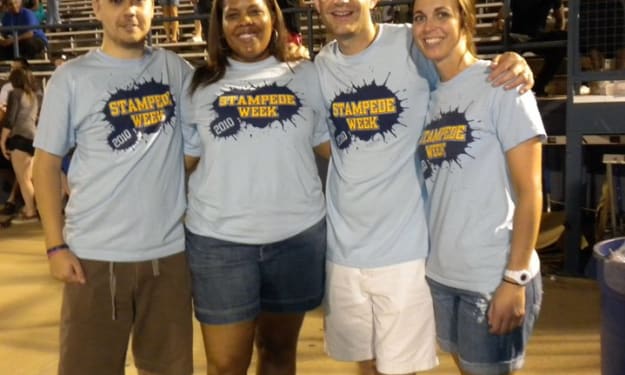
Growing up in Frederick, Oklahoma, you might assume I graduated from high school with a deep understanding of the Tulsa Race Massacre. You might assume that I understood the true heartbreak associated with the Trail of Tears. You might assume I learned about the segregation my ancestors allowed to permeate every facet of our society. You could assume my education offered nuanced views of America’s strengths and an honest assessment of the aspects of our union still in need of perfecting. You could assume failing to grasp these concepts is the byproduct of living in a deeply red state. This might lead you to assume this is not a systemic challenge. Your mind might think, “this is not a challenge facing our bluest cities.” You could assume all of this, but I would fervently argue that you are wrong.
In the classrooms of my small town, I learned a false story about America. Truth would have to be discovered beyond the classroom. After learning these lessons, my perspective on the world was never the same. I spent hours reading, discussing, and reflecting. I thought long and hard about my hometown’s segregated secret. It forced me to ask bold questions about what was done in my name to advance the interests of those who look like me. I had to think deeply about those who were held back so that I might soar. I uncovered these lessons and truths when I confronted real-world examples that felt impossible to ignore.
To begin, I needed to do nothing more than cross the railroad tracks and enter a section of town segregated from the rest. These tracks did more than divide my small town of 5,000 people. Growing up, I often heard this part of town called the flats, ghetto, or, for the cowardly whispering among their friends, N-word town. Standing there, I found racism on every street corner. It would take me two decades to grasp the policy decisions that prevented upward mobility and kept people in unsuitable homes. Redlining, segregation, and loan program rules created this landscape. We, white people, created this system, and it was working as designed.
It was not just this part of town I had to confront. I had to confront the language people used. I heard the “N” word a lot growing up, but never from adults I truly respected. I would watch in horror as a particular friend’s parents played nice to black men hanging outside of a convenience store. Once they were in the safety of their truck, they would bash him with racist tropes. They did not direct this brand of racism to just African Americans. It extended to anyone seen as different. There I learned language matters. Some people who entered and exited my world believed that they were superior to these people and should treat them accordingly. In my later years, far from the classroom, I would come to understand this language was an intimidation tactic used to create a culture of terror. This fear held people down.
Classroom lessons of a different sort were being learned. Not from a lectern or blackboard, I was a witness to racism and prejudicial behavior that existed despite integration. Well into the 90s and early 2000s, teachers often gave white students the benefit of the doubt, second chances, and opportunities to prosper. Teachers often suspended, expelled, or sent kids of color to an alternative school. Seeing kids as impossible and abandoning hope has real-world consequences. The design of our racist society continued to meet its mission.
In those classrooms, they did not teach us the dark and ugly side of Oklahoma or American history. It was whitewashed and gleaming with half-truths. They gave the victors space to tell their version of the story. They taught us to look fondly at those white people who shaped our history. In the same breath, we often ignored the people of color who served as the genesis for change. They did not teach me to question deeply the world around me. Slavery, genocide, Manifest Destiny, Jim Crow, the Civil Rights Movement, assassination, and the systemic way in which racism continues were just names and dates to be memorized.
They looked at any attempt to debate or critical thinking as a nuisance. Of course, saying every teacher in my small town subscribed to this way of thinking would mean painting with a broad brush. There were champions of truth, but it is hard to have deep discussions when you constantly find yourself readying a school for mandated tests.
At 40 years old, thousands of miles removed from my small town, I cannot help but think about the damage this sort of upbringing did to me. How did these experiences shape my worldview, and how did that worldview fail me? How did it set me up for failure? I was a witness to whiteness before I understood the concept of supremacy. I knew redlining before I could name it. I am the product of white privilege. I am standing on the shoulders of a system designed to ensure that I can succeed, often with minimal effort.
When I consider all this, it can feel overwhelming. That is the point. A chorus of politicians and school board members see this discomfort and are choosing to look the other way. They fully understand we stole this land, and we used stolen people to build a country. They fully understand the lasting impact of “whites only,” denial of upward mobility, racism spoken aloud, and racism written into the hearts of men. They see all this and look the other way. They would rather us miss these lessons so we might remain comfortable than deal with their lasting impact.
We cannot recognize the impact of our ignorance. I would argue that when we choose to teach our genuine history, then we set ourselves up to find solutions. This is how we move forward. This is how we progress. This is how we perfect our union. These truths should do more than make you angry. They should open a door and reveal what is possible when we live up to our highest ideals.
When I think about those ideals, equity seems like the logical path forward. Built into the concept of equity is a simple idea of fairness. Now, if you have read this far, you should know this is not an essay attempting to embarrass my hometown. That would not be fair. People from every corner of the map could tell a story like mine. I now call myself a citizen of the Seattle area. Seattle has its own story to tell. On these lands, first Americans were forcibly removed from their land, redlining kept neighborhoods segregated, racist covenants kept people of color from purchasing homes in white neighborhoods, and now gentrification is tearing those neighborhoods apart. No municipality and no state are innocent here.
It has been said time and time again that “we must learn from our history, or we are doomed to repeat it.” Never in the history of our country have those words felt so true.
Be good to each other,
Nathan
About the Creator
Nathan Box
I am a reader, writer, hiker, cinephile, music fanatic who finds himself constantly searching for the next grand adventure.






Comments (1)
This is an excellent story. Something so basic. I would love to share my views as well. I have been a majority in one country and minority in another. I have been a bully and a victim and have seen racial issues from close quarters. I wrote my views here and would love to hear your constructive feedback. https://medium.com/illumination-curated/bullies-within-the-bullied-f54583203f90?sk=b8270fb4cb8cd4e8017bc76c5b945995